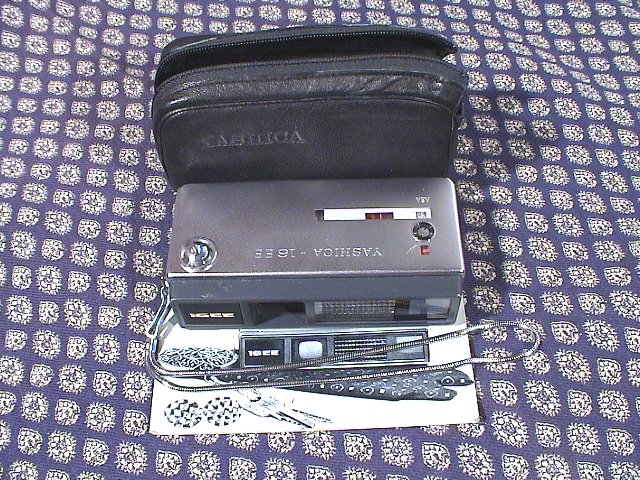Yashica Y16
The Yashica Y16 first appeared in 1959. Following the now familiar bar shape design it is 100x50x31mm and weighs 220g without film. It has a Yashinon 25mm (f3.5-16) fixed-focus lens (a few sources cite an f2.8 version) and the typical 10x14mm negative size. The focal plane shutter has speeds of 1/25, 1/50, 1/100, 1/200 and S. The S is an interesting option that ought to have been emulated on other camera designs. When depressed fully and released quickly it gives 1/10 s. For a "time" exposure the shutter release is pressed partly and released. This opens the shutter. A second continuous press completes the action and closes the shutter. With B you have to hold the shutter open and with T you have to press the shutter twice. S gives the best of both actions.

The other innovation is the unique "Clip-load" film cartridge. These are pushed into the side of the camera and the end is labelled with the film type and speed and replaces a plastic dust cover on the right hand side of the camera. The clip gives 24 exposures on 16mm film. Mid roll switching is possible and for the loss of a single frame. This feature was seen in the Konan Automatic without loss of a frame. Later Minolta cameras not only reset the counter but but would also partly expose a previous frame, the current one and part of the next.
The cassette combined the film chamber with pressure plate and part of the film transport. A gear on the outside of the cassette connects to the spindle on the take up spool; when the film advance wheel of the camera is turned a rod and hence the take up spool. Just over one quarter turn moves tot he next frame making rapid sequence shooting possible. Unfortunately the down fall of the camera is this unique cassette which where difficult to find, limited in film choice and awkward to load (see the Subclub http://www.subclub.org/darkroom/rolly16.htm for details). It is a quality camera, over looked and underrated.
The camera also had a built-in cable release socket, PC contact for flash, and a tripod socket.
The camera is painted a very light grey with several colours available on the front panel
- red/burgundy,
- bronze/old gold,
- royal blue/bright blue ,
- dark grey/charcoal,
- turquoise/aqua/teal.
It was sold for $34.95 in the United States.

A cream colour body is matched with an orange/tangerine front panel and there was even an all-black body available.

Yashica made several clip-on filters: UV, Y2 (yellow), O2 (orange), 1A, 82A, 81B and 80A. The filters hold on to the front of the camera with a little "pegs". They also made a full line of accessories, such as a film loader, a flash gun, electronic flash holder, a cable release, a Self-Timer, a developing tank, a slide viewer and a slide projector.
The fixed point of focus on the Y16 focus was at 2.4m (8 feet), so that at f3.5 the near point is about 2m (6.5 feet) and the far point is 3.2m (10.75 feet). Stopped down to f16 everything is sharp from 1.3m (4 feet) to infinity.
After the failure of the Y16, Yashica opted to try a camera using the popular Minolta cassette, the Yashica 16EE.
Yashica 16EE / 16EE Deluxe
The Yashica 16 EE was introduced in 1964. It is very similar in design and features to the Minolta 16EE which came out two years earlier but is more elegant in appearance. If has a fixed focus 25mm f2.8 lens. Stopped down to f16. It has a selenium meter with fully automatic exposure control from ISO 32 to 320. The exposure window shows "correct exposure", "over exposure", or under exposure". Shutter speed range from 1/30 - 1/250. For flash use, the aperture could be manually set and the shutter speed would automatically be set to 1/30; another improvement over the Minolta 16EE. Mechanically more sophisticated than the Minolta 16EE since the meter sets both aperture and shutter speed it still failed to sell well.
The camera had a normal eye-level viewfinder, but by flipping the camera over and looking that the bottom a built-in right-angle viewfinder could be used - images reversed.
Also built-in are a PC contact, tripod socket and cable release socket. Accessories included tripod and filters.
Although made by Yashica, not by Minolta, it used the Minolta cassette and Yashica turned out to be a major seller of "Minolta" cassettes. They are only slightly different from real Minolta cassettes and inter-changeable with Minolta 16 cameras. Films without a plastic case in small red boxes with Yashica 16EE or Minolta 16 on them where sold in the 60s and 70s. These where made in Germany and are not as good as the standard Minolta cassettes.

Although the camera just says Yashica EE without "DELUXE" ("DELUXE" just appears on the box) it is an updated version of the Yashica EE and sold in the mid 1960s. The ASA dial expanded from the original 4 settings (32, 80, 100, 320) to accept 9 settings (ASA 25, 32, 40, 50, 64, 80, 100, 160, 320).
This was the last of the Yashica 16mm cameras. It failed to sell well and then Yashica tried cameras using the Minox cassette (see the Yashica Atoron) with moderate success. All of Yashica's subminiature cameras are well made and performers well.